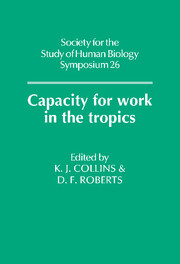Book contents
- Frontmatter
- Contents
- Preface
- Measurement of Working Capacity in Populations
- Functional Consequences of Malnutrition
- Growth, Stature and Muscular Efficiency
- Ethnic and Socio-Cultural Differences in Working Capacity
- Genetics of working capacity
- Working capacity in different African groups
- Environmental, genetic and leg mass influences on energy expenditure
- Sociocultural influences on the working capacity of elderly Nepali men
- Energy Expenditure and Endemic Disease
- Research Models in Tropical Ecosystems
- Index
Environmental, genetic and leg mass influences on energy expenditure
Published online by Cambridge University Press: 15 March 2010
- Frontmatter
- Contents
- Preface
- Measurement of Working Capacity in Populations
- Functional Consequences of Malnutrition
- Growth, Stature and Muscular Efficiency
- Ethnic and Socio-Cultural Differences in Working Capacity
- Genetics of working capacity
- Working capacity in different African groups
- Environmental, genetic and leg mass influences on energy expenditure
- Sociocultural influences on the working capacity of elderly Nepali men
- Energy Expenditure and Endemic Disease
- Research Models in Tropical Ecosystems
- Index
Summary
The effects of physical environment, genetic background and muscle mass volume of the extremities on energy expenditure of humans at rest and at maximum work capacity is an intricate physiological problem. Human energy turnover comprises the continuous anabolic and catabolic processes in which transformation of chemical, mechanical, electrical and thermal energies takes place, part of them being transformed to heat. Thus metabolic heat is produced which is the basic mechanism for maintaining body temperature at its normal level. Exposure to heat and cold provokes thermoregulatory reactions like vasodilatation or vasoconstriction, shivering or sweating, while body metabolism is affected as well. Much useful information regarding thermoregulation has been accumulated in populations living in extreme cold like Eskimos, or in primitive conditions with apparently inadequate protection, such as the Australian Aborigines. It is interesting to recall that while the Australian Aborigine can sleep naked through a moderately cold night without recourse to raising his body metabolism and therefore his body temperature can fall to about 35°C, the arctic Eskimo maintains normal body temperature when exposed to cold at the expense of greater metabolic heat production, being unable to tolerate a fall of his body temperature.
In hot climates when the impact of environmental heat overrides the heat dissipation capacity of the human body, body temperature tends to rise. Under these circumstances lowering of metabolic heat production would alleviate the temperature rise. This could be particularly advantageous during exercise when thermoregulation is aggravated by increased metabolism and heat build up.
- Type
- Chapter
- Information
- Capacity for Work in the Tropics , pp. 205 - 214Publisher: Cambridge University PressPrint publication year: 1988

